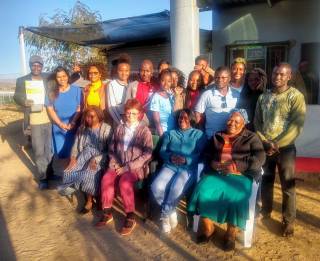Fieldwork in a new location is always an exciting undertaking. As a part of the MSc in Biodiversity, Conservation and Management at the School of Geography and the Environment, I was fortunate to be able to carry out my dissertation fieldwork in a fascinating location. Here are a few snippets from my adventures in Namibia – one of the youngest nations in Africa, and home to some of the most ancient landscapes on the planet.
Scoping for a topic
While trying to identify a good research topic for my dissertation, one of the primary objectives was to feed into a larger initiative that had real-world implications, preferably based on the nexus between climate change and natural ecosystems. The answer to my search came in the form of the Urban Ecolution project (UE), which was a collaboration between the Universities of Cape Town (South Africa) and York (UK), exploring ecosystem-based climate solutions for poorer urban communities in Sub-Saharan Africa (read my full post on this search here).
I worked with Dr. Jessica Thorn, Urban Ecolution’s Primary Investigator (and Oxford alumna), in order to co-design a project for UE’s field site in Windhoek, the capital of Namibia. After a whirlwind of proposals, grant applications, CUREC forms (the dreaded ethics approval process), and logistical coordination, I was all set for my field season in Namibia’s capital.
Background to the project
After gaining independence from apartheid South Africa in 1990,Namibia has been on a pathway of increasing urbanization. Windhoek’s formal housing market struggled to meet the lower purchasing power of the large influx of rural-urban migrants that associated this change. The result was the creation of vast informal settlements on the periphery of the city, made up of corrugated iron shacks, which continue proliferating to this day.
Namibia is also an arid, water-scarce dryland landscape, and climate models predict that it will be one of the worst impacted countries in Sub-Saharan Africa under various climate change scenarios. In this context, residents of informal settlements become the most vulnerable segment of the city’s population, due to the lack of basic services, presence of shack homes in hazardous zones, and residents’ strained financial circumstances.
My project was investigating the scope for incorporating ecosystem-based adaptation (which involves management of biodiversity and natural ecosystems to achieve human wellbeing and climate adaptation benefits) into Windhoek’s brand new climate change strategy. I had to talk to a range of stakeholders, especially residents in informal settlements, in order to gauge the opportunities and trade-offs associated with trying to manage natural ecosystems to gain these kinds of ecosystem services.
The findings
While carrying out these focus groups and interviews, I was given a window to the spirit of Namibians, who are incredibly proud of their young nation and their hard-won freedom. However, the quality of life of the urban poor has been slow to improve, and the income disparity remains stark. The central business district of Windhoek could rival any such district in a small western nation, but just a few kilometres outside, the informal settlements seem a world apart. I was strongly reminded that, in many of our cities, the most vulnerable usually fall under the radar of both authorities and citizens, and yet they represent a vast untapped resource, as many are job seekers and youth capable of contributing to the country’s productivity.
In terms of my project, I surmised that there were many aspects of the natural environment that had been completely overlooked in and around informal settlements. This had led to the degradation of the landscape, as immediate needs for survival had surpassed the awareness of long-term benefits from nature. Trees are harvested at an alarming rate as fuelwood, and the lack of sanitation facilities meant that watercourses doubled up as toilets. This is also due to an acute lack of information and awareness about the benefits that people stood to gain from biodiversity and maintenance of nature. My project recommended the mainstreaming of these considerations into the city’s and settlements’ policies and plans, through a few different pathways.
Falling in love with a country
I also had the opportunity to experience the stunning landscapes, rich wildlife and amazing culture of Namibia, travelling to the Etosha National Park and the coastal town of Swakopmund. Watching the blazing African sun set over the Namib sand dunes just by the ocean, it was easy to see why Namibia is a magnet for tourists and adventure seekers across the planet. It is a country that has much to offer, yet it also needs to grapple with the immediate needs of equitable development for all its citizens. I left with a full heart, having had the best experience of my life in this beautiful nation, and remain hopeful that I will be able to return to a flourishing country!
Amayaa Wijesinghe (2018)
Amayaa has just completed her MSc in Biodiversity, Conservation and Management, and is currently a Researcher with the Urban Ecolution Research Programme (Africa Climate and Development Initiative, Cape Town, South Africa). She is grateful for the support Linacre College provided for her fieldwork through the Frederick Mulder Fund, as well as the Common Room Endowment.
Focus group discussions with community leaders and youth from informal settlements.



















